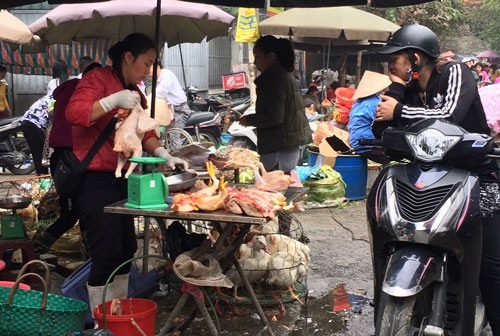 Society
Society

The Ministry of Health urged city and provincial people’s committees, health departments and citizens across the country to take preventions against a possible bird flu over the next 16 days ahead of the Lunar New Year and during first months of the new year.
 |
| The Health Ministry is urging people across the country to be on alert against bird flu outbreaks before and after Tết.-- Photo ntd.com.vn |
HÀ NỘI -- The Ministry of Health urged city and provincial people’s committees, health departments and citizens across the country to take preventions against a possible bird flu over the next 16 days ahead of the Lunar New Year and during first months of the new year.
Trần Đắc Phu, Director of the Department of Preventive Medicine at the Ministry, said that the urgent recommendation came after evaluations during the late months of 2017 and early 2018 showing that newly-emerging infectious diseases such as Mers - CoV continue to be reported in the Middle East, along with influenza A/ H7N9 in China, nld.com.vn online newspaper reported.
Meanwhile in Việt
According to Phu, from January 17 to 19, bird flu was detected at a poultry-breeding farm in Diễn Châu District, the central
Nearly 200 of the 800 poultry at the farm died, while the farm’s owner reported his poultry herd wasn’t vaccinated against bird flu.
The Department of Animal Health at the Ministry of Agriculture and Rural Development has warned that many types of influenza A /H7N9 virus and other highly virulent strains such as A/ H5N2, A/H5N8 that haven’t yet appeared in Việt
The main route of transmission was smuggling of poultry and unknown-origin poultry products. Therefore, the Department of Animal Health asked local authorities to be active in prevention and controlling the threat of bird flu outbreaks, strengthen inspection and strictly tackle poultry smuggling and illegal transporting.
Local authorities and relevant departments should closely monitor the situation to ensure timely action against outbreaks.
About the possibility of a bird flu outbreak in the Tết period and first months of the new year, the Ministry of Health warned the disease could present a complicated challenge due to the spring weather, people’s over-use of food during and after Tết holidays and high travel demand. All these factors increase the risk of transmission.
Nguyễn Văn Kính, Director of the
According to health experts, the virus strain of A / H7N9 is one of the major threats in the world. Influenza A/H7N9 was recorded in 2013 in
In 2017, influenza A/H7N9 outbreak in
The World Health Organization (WHO) and the United Nations Food and Agriculture Organization (FAO) have warned that the influenza A / H7N9 virus strain has changed from low to high virulence in both poultry and humans. It can kill 100 per cent of infected poultry and can transmit 100-1,000 times faster than a low virulence virus. People with this flu may develop edema, heart failure, severe liver failure, coma and death, according to two organizations.
Epidemiological assessments of the flu epidemic are difficult to predict because of differing virulence in influenza strains. For example, the A/H1N1 flu is dangerous at first, but actually the mortality rate is low, only 0.09 per cent. Meanwhile, H5N1 has a mortality rate of 70 per cent to 90 per cent, even up to 100 per cent at some periods. H7N9 also reported a mortality rate of 50 – 60 per cent.
“So far, the world has recorded many influenza pandemics. The Ministry of Health recommends people actively prevent the flu amid the increasing number of flu cases early this year," said Trần Đắc Phu.
In Việt

.jpg)
.jpg)

